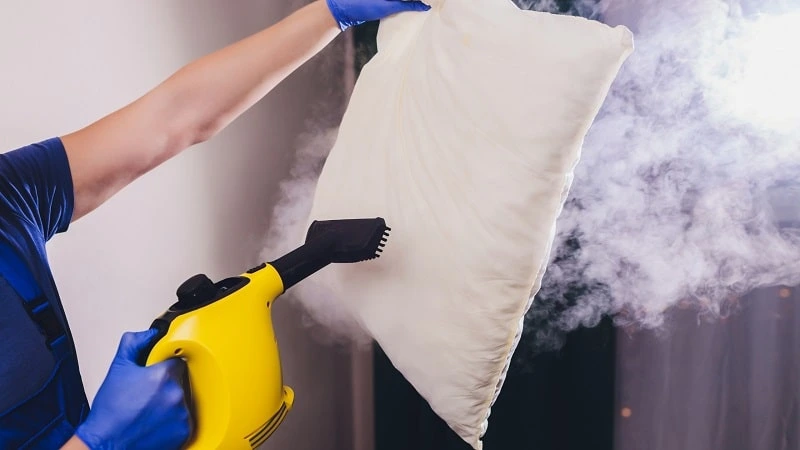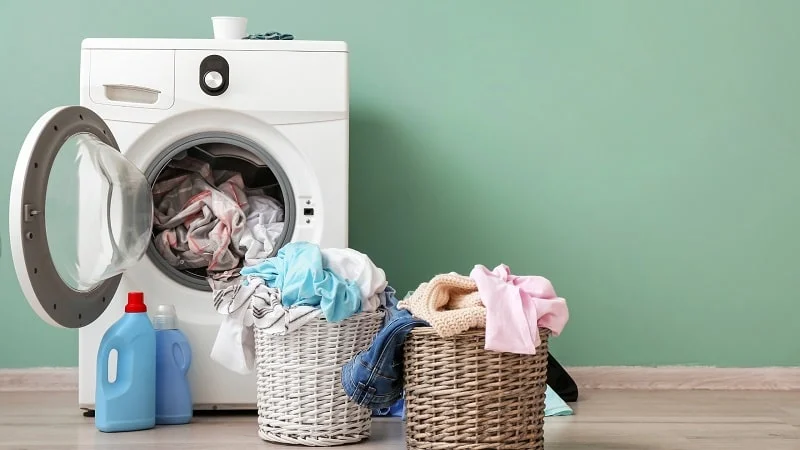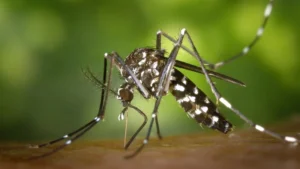Maintaining a clean living space is vital, especially in the aftermath of the COVID-19 pandemic. Among the overlooked areas, pillows demand our attention. As we seek comfort in them, pillows also gather germs, potentially including the COVID-19 virus. This makes knowing “how to sanitize pillows after COVID” crucial.
Just as we wash our hands and disinfect surfaces, tending to our pillows ensures a hygienic environment. Discovering the steps to properly clean and sanitize pillows not only safeguards us from possible illness but also contributes to an overall healthier home.
Understanding Pillows and Their Importance
Pillows are more than just comfy cushions; they play a significant role in our daily lives by offering comfort and support during sleep and rest.
However, these soft companions also collect various things like dust, sweat, and even dead skin cells. This can make them a breeding ground for germs and potentially harmful microorganisms.
Role in Sleep Comfort
Pillows provide a cozy surface for your head and neck while you sleep. They help maintain a natural alignment of your spine and keep your neck from twisting uncomfortably during the night.
Read More: Ear and Jaw Pain on One Side Due to Covid
Accumulation of Debris
Over time, pillows accumulate not only the tiny particles we can see, like dust, but also invisible things like sweat and skin cells that we naturally shed.
These elements create an environment where bacteria and other microorganisms can thrive.

Potential Health Implications
The accumulation of germs and allergens in pillows can lead to health issues, including allergies, respiratory problems, and skin irritations.
This is especially important to consider in a world recovering from the impact of the COVID-19 pandemic.
Importance of Regular Cleaning
Cleaning and maintaining your pillows on a regular basis help remove the built-up debris, ensuring a healthier sleep environment.
It’s not just about fluffing them up; it’s about creating a clean and safe place to rest your head each night.
How to Sanitize Pillows After Covid?
Properly sanitizing pillows after potential exposure to COVID-19 is essential in maintaining a clean and safe sleep environment. Here’s a step-by-step guide to help you effectively sanitize your pillows.
Step 1: Check Care Instructions
Before you begin, check the care label on your pillows. This will help you determine whether your pillows are machine washable and provide specific guidelines for cleaning.
Step 2: Machine Washing
If your pillows are machine washable, use a gentle cycle with warm water. Add a mild detergent to help break down oils and germs. Use an extra rinse cycle to ensure the detergent residue is thoroughly removed.

Read More: What Does Covid Fatigue Feel Like?
Step 3: Drying
After washing, it’s important to dry your pillows thoroughly to prevent mold and mildew growth. Place them in the dryer on a low heat setting. Adding clean tennis balls or dryer balls can help fluff the pillows and maintain their shape.
Step 4: Non-Washable Pillows
If your pillows can’t be machine washed, consider using a fabric-safe disinfectant spray. Apply the spray according to the product’s instructions, making sure to cover the entire surface.
Step 5: Sunlight Exposure
UV rays from sunlight can help disinfect pillows naturally. If possible, place your pillows in direct sunlight for a few hours. Remember to flip them to ensure both sides receive sunlight exposure.
Step 6: Pillow Protectors
Consider using pillow protectors to create an additional barrier between your pillows and potential contaminants. Pillow protectors are easier to clean and can extend the life of your pillows.
Step 7: Pillowcases
Regularly wash and change your pillowcases to prevent the accumulation of oils, sweat, and germs. Use hot water to help effectively sanitize them.
How COVID-19 Spreads and Its Survival on Surfaces
Understanding how COVID-19 spreads and survives on surfaces is essential for keeping our environment safe and preventing potential transmission.
Spreading through Respiratory Droplets
COVID-19 mainly spreads through small respiratory droplets that come from an infected person when they talk, cough, or sneeze. These droplets can land on various surfaces, including pillows.
Read More: Back of Neck Pain COVID: Know the Reasons
Prolonged Survival on Different Surfaces
Once these droplets settle on surfaces like pillows, the virus can remain viable for different periods. The length of survival depends on factors such as surface material, humidity levels, and temperature.
Variability with Surface Materials
COVID-19’s survival on surfaces can differ based on the material of the surface. Porous materials, like fabric pillows, may offer places for the virus to stay, while less porous surfaces, like plastic, might allow the virus to survive longer.
Risk of Contact Transmission
If you touch a contaminated surface, such as a pillow with the virus, and then touch your face—especially the eyes, nose, or mouth—you could potentially introduce the virus into your body.
Significance of Surface Cleaning
To reduce the risk of virus transmission, it’s crucial to regularly clean and disinfect surfaces, including pillows. By doing so, you help minimize the chance of the virus lingering and spreading.
Why Sanitizing Pillows is Essential
Understanding the importance of sanitizing pillows goes beyond comfort – it’s about safeguarding our health and well-being.
Minimizing Virus Transmission
Sanitizing pillows is vital for reducing the potential transmission of viruses like COVID-19. Close contact with pillows, especially during sleep, can expose us to lingering pathogens.

Breaking the Chain of Contamination
Pillows can act as carriers for germs and pathogens, transferring them to other surfaces and people. Sanitizing pillows breaks this chain of contamination and helps prevent the spread of illness.
Protecting Vulnerable Individuals
Sanitizing pillows is particularly crucial for protecting vulnerable individuals, such as the elderly, those with weakened immune systems, or individuals with pre-existing health conditions. These individuals are at higher risk of severe illness from infections.
Creating a Clean Sleep Environment
A clean sleep environment is conducive to better overall health. Sanitizing pillows promotes better sleep quality by reducing allergens, germs, and irritants that can disrupt sleep and contribute to health issues.
Read More: A New Covid infection (Omicron); ba.2 Variant Symptoms
Contributing to General Hygiene
Just as we wash our hands and clean our surroundings, maintaining clean pillows contributes to overall hygiene. It’s a proactive step we can take to ensure a healthier living space.
Conclusion
In the wake of the COVID-19 pandemic, maintaining a clean and sanitary living environment takes on heightened importance.
Properly sanitizing pillows is a key step in this effort. While pillows offer comfort, they can also harbor germs, including potential pathogens.
By understanding how COVID-19 spreads, the survival of the virus on surfaces, and the essential role of proper sanitization, we can take proactive measures to safeguard our health and the well-being of those around us.
Regular cleaning of pillows not only reduces the risk of virus transmission but also contributes to a healthier sleep environment overall.
FAQs
Q1: Can COVID-19 survive on pillows for long?
A1: The survival of COVID-19 on pillows varies based on factors like material, humidity, and temperature. Studies suggest it can survive for hours to days.
Q2: How often should I sanitize my pillows?
A2: Regularly sanitizing your pillows, at least once every few weeks, is recommended to maintain a clean sleep environment.
Q3: Can I wash all types of pillows in a washing machine?
A3: Check the care label on your pillows. While many pillows are machine washable, some may require alternative cleaning methods.
Q4: Can exposure to sunlight sanitize pillows?
A4: Sunlight exposure can help kill germs. Leave your pillows in direct sunlight for a few hours to aid in sanitization.
Q5: Are fabric disinfectant sprays safe for pillows?
A5: Yes, fabric-safe disinfectant sprays can be used on pillows. Follow the product instructions for proper usage.
Q6: Can I use bleach to sanitize pillows?
A6: It’s not recommended to use bleach on pillows as it can degrade the material and leave harmful residues.
Q7: How do I ensure my pillows are completely dry after cleaning?
A7: Use a low heat setting in the dryer and consider using dryer balls or clean tennis balls to help fluff the pillows and prevent clumping.
Q8: Can sanitizing pillows prevent all illnesses?
A8: While sanitizing pillows reduces the risk of illness transmission, it’s essential to follow other hygiene practices, like handwashing and social distancing, to prevent the spread of diseases.
Q9: Is sanitizing pillows important for people who’ve been vaccinated against COVID-19?
A9: Yes, sanitizing pillows remains important, as vaccinated individuals can still carry and potentially transmit the virus to others.
Medical References
- World Health Organization (WHO). Coronavirus disease (COVID-19) advice for the public: Mythbusters.
- Centers for Disease Control and Prevention (CDC). Cleaning and Disinfection for Households.
- National Institutes of Health (NIH). Stability of SARS-CoV-2 in different environmental conditions.
- Mayo Clinic. How to safely use disinfectants.
- American Academy of Allergy, Asthma & Immunology (AAAAI). Dust Mite Allergy.
- Sleep Foundation. Pillow Hygiene: How Clean Is Your Pillow?



